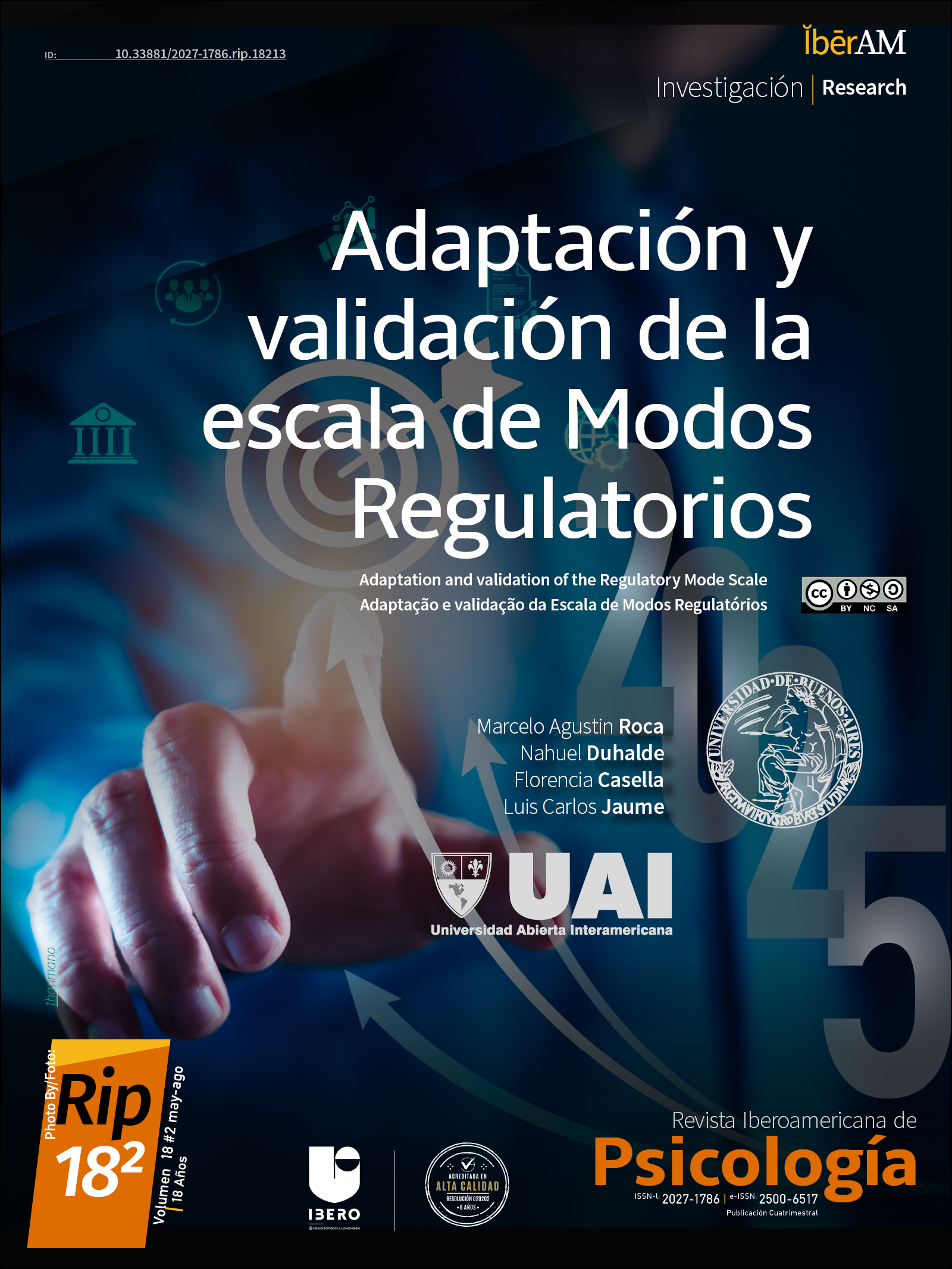Adaptación y validación de la escala de Modos Regulatorios
Adaptation and Validation of the Regulatory Modes Scale
Contenido principal del artículo
Los modos regulatorios pueden definirse como las distintas formas de actuar para alcanzar un determinado objetivo. Existen dos tipos de modos regulatorios funcionalmente independientes uno del otro: la locomoción y la evaluación. La locomoción se refiere a la capacidad de iniciar y mantener el movimiento hacia una meta, mientras que la evaluación se centra en la comparación crítica de alternativas para determinar la mejor opción. A pesar de que muchos autores han profundizado en la temática, existe una escasez de investigaciones que aborden los modos regulatorios y la validación de su escala en países de América Latina. La presente investigación tiene como objetivo adaptar el instrumento y brindar evidencias sobre su validez de constructo, de criterio y confiabilidad en el contexto argentino. Para ello, se utilizó una muestra de 230 individuos argentinos para el estudio piloto y 713 para el estudio principal. Con la muestra piloto se llevó a cabo un Análisis Factorial Exploratorio, mientras que con la muestra del estudio principal se realizó un Análisis Factorial Confirmatorio. Los resultados llevaron a la eliminación de algunos ítems, obteniendo así propiedades psicométricas adecuadas. Finalmente, se constituyó una escala de “locomoción” de cinco ítems y otra de “evaluación” de cinco ítems, ambas con niveles de confiabilidad satisfactorios y una asociación positiva entre sí. Este trabajo proporciona un primer acercamiento a esta temática en Argentina, facilitando la posibilidad de utilizar estas escalas en futuros estudios.
Descargas
Datos de publicación
Perfil evaluadores/as N/D
Declaraciones de autoría
- Sociedad académica
- Bogotá: Corporación Universitaria Iberoamericana
- Editorial
- Bogotá: Corporación Universitaria Iberoamericana
Detalles del artículo
Ballester Esteve, I., Fernández Piqueras, R., & Parra-Camacho, D. (2021). Adaptación y validación de una escala para la evaluación del desempeño profesional del entrenador de fútbol en base a su formación permanente, nivel de TIC y autoevaluación. Retos: Nuevas tendencias en Educación Física, Deportes y Recreación, 40, 272-280. https://doi.org/10.47197/retos.v1i40.83157
Choy, E. E. H., & Cheung, H. (2018). Time perspective, control, and affect mediate the relation between regulatory mode and procrastination. PLOS ONE, 13(12). https://doi.org/10.1371/journal.pone.0207912
Chen, F. F. (2007). Sensitivity of Goodness of Fit Indexes to Lack of Measurement Invariance. Structural Equation Modeling: A Multidisciplinary Journal, 14(3), 464–504. https://doi.org/10.1080/10705510701301834
Cheung, G. W., & Rensvold, R. B. (2002). Evaluating goodness-of-fit indexes for testing measurement invariance. Structural equation modeling, 9(2), 233-255. https://doi.org/10.1207/S15328007SEM0902_5
Da Silva, J. D., Faia, V. D. S., & Vieira, V. A. (2016). The negative effects of experience and control on salesperson's performance/Os efeitos negativos da experiencia e do controle no desempenho do vendedor/Los efectos negativos de la experiencia y del control en el desempeno del vendedor. RAE, 56(6), 626-641. https://periodicos.fgv.br/rae/article/view/64792
DeVellis, R. F. (2017). Scale Development: Theory and Applications (4ta. Ed.). Sage Publications. https://collegepublishing.sagepub.com/products/scale-development-5-269114
Dominguez-Lara S. (2018). Reliability and ordinal alpha. Fiabilidad y alfa ordinal. Actas urológicas españolas, 42(2), 140–141. https://doi.org/10.1016/j.acuro.2017.07.002
Elosua, P. (2005). Evaluación progresiva de la invarianza factorial entre las versiones original y adaptada de una escala de autoconcepto. Psicothema, 17(2), 356-362. https://reunido.uniovi.es/index.php/PST/article/view/8281
Higgins, E. T., Kruglanski, A. W., & Pierro, A. (2003). Regulatory mode: Locomotion and assessment as distinct orientations. Advances in Experimental Social Psychology, 35, 293–344. http://dx.doi.org/10.1016/S0065-2601(03)01005-0
Hinton, P. (2014). SPSS Explained. Milton Park: Routledge. https://doi.org/10.4324/9781315797298
Hu, L. T., & Bentler, P. M. (1999). Cutoff criteria for fit in-dexes in covariance structure analysis: Conventional criteria versus new alternatives. Structural Equation Modeling: A Multidisciplinary Journal, 6(1), 1-5. https://doi.org/10.1080/10705519909540118
Jaume, L. C., Schetsche, C., Roca, M. A., & Quattrocchi, P. (2022). Factor Structure and Internal Consistency on a Reduced Version of the Revised Test of Need for Cognitive Closure. Frontiers in Psychology, 12, 813115-813115. https://doi.org/10.3389/fpsyg.2021.813115
Jaume, L. C., & Roca, M. A. (2020). La evaluación del perdón, los modos regulatorios y la necesidad de cierre cognitivo: construyendo una agenda de investigación. Subjetividad y Procesos Cognitivos, 24(1), 1-21. http://dspace.uces.edu.ar:8180/xmlui/handle/123456789/5366
Jordan Muiños, F. M. (2021). Valor de corte de los índices de ajuste en el análisis factorial confirmatorio. Psocial, 7(1), 66-71. http://portal.amelica.org/ameli/journal/123/1232225009/
Kruglanski, A. W., Dechesne, M., Orehek, E., & Pierro, A. (2009). Three decades of lay epistemics: The why, how, and who of knowledge formation. European Review of Social Psychology, 20(1), 146-191. https://doi.org/10.1080/10463280902860037
Kruglanski, A. W., Pierro, A., Mannetti, L., & Higgins, T. E. (2013). The distinct psychologies of “looking” and “leaping”: Assessment and locomotion as the springs of action. Social and Personality Psychology Compass, 7(2), 79-92. https://doi.org/10.1111/spc3.12015
Kruglanski, A. W., Thompson, E. P., Higgins, E. T., Atash, M. N., Pierro, A., Shah, J. Y., & Spiegel, S. (2000). To "do the right thing" or to "just do it": Locomotion and assessment as distinct self-regulatory imperatives. Journal of Personality and Social Psychology, 79(5), 793–815. https://doi.org/10.1037/0022-3514.79.5.793
Leys, C., Delacre, M., Mora, Y. L., Lakens, D., & Ley, C. (2019). How to Classify, Detect, and Manage Univariate and Multivariate Outliers, With Emphasis on Pre-Registration. International Review of Social Psychology, 32(1): 5, 1–10. https://doi.org/10.5334/irsp.289
Liu, H., Rubenstein A. L., Li G., Liu, Z., Zhan, X, & Xiong, J. (2022) A time to consider, a time to deliver: The independent and interactive effects of regulatory mode on innovative work behavior. Journal of product innovation management, 39, 202–221. https://doi.org/10.1111/jpim.12614
Mardia, K. V. (1970). Measures of multivariate skewness and kurtosis with applications. Biometrika, 57, 519–530. https://doi.org/10.1093/biomet/57.3.519
Montero, I., & León, O. G. (2007). A guide for naming research studies in Psychology. International Journal of Clinical and Health Psychology, 7(3), 847-862. https://psycnet.apa.org/record/2007-14302-016
Morris, R. & Pinelli, F. (2022) The cognitive, neural, and social aspects of regulatory mode and its implications on well-being and decision-making. Journal of European Psychology Students, 13(1), 78–92. https://doi.org/10.5334/jeps.568/
Pica, G., Jaume, L.C. & Pierro, A. (2020). Let’s go forward, I forgive you! On motivational correlates of interpersonal forgiveness. Current Psychol, 41, 6786–6794. https://doi.org/10.1007/s12144-020-01180-7
Pica, G., Mallia, L., Pierro, A., Alivernini, F., Borellini, V., & Lucidi, F. (2019). How stressful is retirement! Antecedents of stress linked to athletes’ career termination. Journal of Applied Social Psychology, 49(8), 488-497. https://doi.org/10.1111/jasp.12599
Pierro, A., Chernikova, M., Lo Destro, C., Higgins, E. T., & Kruglanski, A. W. (2018). Assessment and locomotion conjunction: How looking complements leaping…but not always. Advances in Experimental Social Psychology, 58, 243–299. https://doi.org/10.1016/bs.aesp.2018.02.001
Pierro, A., & Kruglanski, A. W. (2005). Revised Need for Cognitive Closure Scale. (Unpublished Manuscript). La Sapienza: Università di Roma. https://creativeengagementlab.com/sites/default/files/2024-01/Need-For-Closure-Scale-short-version.pdf
Scholl, A., Wenzler, M., Ellemers, N., Scheepers, D., & Sassenberg, K. (2021). Just do it or do it right? How regulatory mode relates to perceived responsibility and opportunity in collaborations. Personality and Individual Differences, 176, 110776. https://doi.org/10.1016/j.paid.2021.110776
Smith, G. T., McCarthy, D. M., and Anderson, K. G. (2000). On the sins of short-form development. Psychol. Assess. 12, 102–111 https://doi.org/10.1037/1040-3590.12.1.10
R Core Team (2023). R: A language and environment for statistical computing [Software informático]. https://www.R-project.org/
Ugarte Ontiveros, D., & Aparicio de Guzman, R. M. (2020). Técnicas robustas y no robustas para identificar outliers en el análisis de regresión. Investigación & Desarrollo, 20(2), 41-56. https://doi.org/10.23881/idupbo.020.2-3e
Tabachnick, B. G., & Fidell, L. S. (2012). Using multivariate statistics (6a Ed.). Pearson
Vazeou-Nieuwenhuis, A., Orehek, E., & Scheier, M. F. (2017). The meaning of action: Do self-regulatory processes contribute to a purposeful life? Personality and Individual Differences, 116, 115–122. https://doi.org/10.1016/j.paid.2017.04.040
Webb, C. E., Coleman, P. T., Rossignac-Milon, M., Tomasulo, S.J., & Higgins, E. T. (2017). Moving on or digging deeper: Regulatory mode and interpersonal conflict resolution. Journal of Personality and Social Psychology, 112(4), 621–641. https://doi.org/10.1037/pspp0000131
Webster, D. M., & Kruglanski, A. W. (1994). Individual differences in need for cognitive closure. Journal of personality and social psychology, 67(6), 1049. https://doi.org/10.1037/0022-3514.67.6.1049












